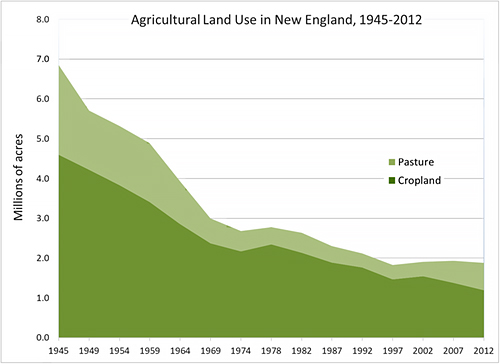USDA Researching New England's Ability to be Self-Reliant in Food Production
Contact: Autumn Canaday
Email: Autumn Canaday
June 5, 2023
Rarely do we ever know how much food is actually grown, produced, and then circulated from within a sub-national region. But researchers at the U.S. Department of Agriculture's (USDA) Agricultural Research Service (ARS) recently participated in a cross-institutional study involving 16 researchers to determine what it would take for New England states to increase its regional self-reliance to 30 percent by 2030.
The research shows that New England (Connecticut, Maine, Massachusetts, New Hampshire, Rhode Island, and Vermont) produces a small number of foods, like cranberries and potatoes, in large amounts relative to consumption, but for most foods, regional production is quite low.
"Doesn't everyone want to know where their food is from?" said Christian Peters, ARS' research leader for the Food Systems Research Unit in Burlington, Vt. "This research addresses the current and potential capacity of New England to source its own food. It's important that we understand the current balance of production to consumption to avoid being unduly pessimistic or overly optimistic about the role of local and regional production in the overall food supply."
Peters and the research team contributed to the New England Feeding New England study, released today, June 5, 2023, by constructing a model to explore New England's potential to increase its self-reliance. Copies of the research can be downloaded at: https://nefoodsystemplanners.org/projects/report-components/. The model starts with assumptions about what people will eat and targets how much of that food will be supplied within the region. It then calculates the amount of food commodities required to supply the food people eat (in both servings and kilocalories), accounting for losses and waste that occur between the farm and the fork. Next, researchers calculated the area of land required to produce each food commodity based on regional crop yields and the feed requirements for raising livestock.
While developing the model, the research team also conducted a series of focus groups with producers from different sectors of the region's food system to get stakeholder input on New England's barriers and opportunities to produce a greater share of its food than it does in currently. The team then used this model to estimate how much food could be produced on existing agricultural land and how much additional land would be needed to supply 30 percent of the region's food by 2030. Information from these focus groups helped place the model results in context.
 The data used to produce this figure come from the Major Land Uses dataset. USDA Economic Research Service. 2017. Major Land Uses [CSV Format of Historical Data]. US Department of Agriculture, Economic Research Service.
The data used to produce this figure come from the Major Land Uses dataset. USDA Economic Research Service. 2017. Major Land Uses [CSV Format of Historical Data]. US Department of Agriculture, Economic Research Service.
The study found that reaching 30 percent self-reliance would require bringing close to 1 million acres of farmland into production (400,000 from farmland that is currently underutilized or idle and 590,000 in land that was once farmed but has returned to trees), reversing a century-long trend of land leaving agriculture. Total land in cropland and grassland pasture across the six-state region has hovered around 1.9 million acres since 1997. A possible pathway to increasing food self-reliance, without clearing new land, involves leaving less land idle and converting to crops that require more intensive cultivation (e.g., field crops or vegetables vs. hay crops or grazing land).
Other factors affecting self-reliance include land costs, competition with other land uses, and a shifting age demographic among farming and seafaring producers throughout New England.
Scientists at the Food System Research Unit are currently developing a five-year plan for research and considering how questions raised by the New England study might be pursued in greater depth. For example, where might additional land be brought into production and at what economic and environmental cost?
"Our research model allows us to consider changes in crop productivity, livestock management, and the use of agricultural land," said Peters. "The Food Systems Research Unit will continue to build an interdisciplinary team and to explore the benefits and drawbacks of New England meeting this benchmark by 2030."
Funding for this foundational research project came from the USDA Regional Food System Partnership Program and two private foundations and was administered by the Vermont Sustainable Jobs Fund on behalf of the New England Food System Planners Partnership.
The Agricultural Research Service is the U.S. Department of Agriculture's chief scientific in-house research agency. Daily, ARS focuses on solutions to agricultural problems affecting America. Each dollar invested in U.S. agricultural research results in $20 of economic impact.
